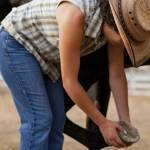Off-Season Hoof Care for Horses

Horse owners know well that routine hoof care doesn’t end when the leaves fall from trees and the mercury dips. The type of care, however, might change as a horse’s lifestyle shifts from season to season. A conscientious, skilled farrier will keep the hooves in order, but what can you, as an owner, do nutritionally for your horse’s hooves during the off-season?
Maintain a balanced diet. Diets change based on performance expectations. A horse whose exercise schedule has downshifted from intense work five days a week to light hacking every two or three days probably requires an overhaul, reducing calorie intake to support a lighter workload. “Regardless of changes in energy density, all horses need a full complement of vitamins and minerals. To ensure this, feed the recommended amount of a well-fortified feed, offer a balancer pellet, or provide a vitamin and mineral supplement formulated by a reputable company,” said Catherine Whitehouse, M.S., an advisor at Kentucky Equine Research (KER). Are you unsure if your horse’s diet is complete? Ask a nutrition advisor from KER.
In the same vein, the fat content of green pasture and hay is markedly different, with hay having about half the fat as green, growing grass. Fat supplementation may help dry hooves which, in turn, could help prevent chipping and cracking. “When choosing a fat source, select one that provides plenty of omega-3s, such as canola oil or fish oil,” advised Whitehouse. “One direct source of the omega-3 fatty acids DHA and EPA, which are the most biologically active, is the fish oil product EO-3.”
Consider dietary changes in formulating an off-season diet. As the forage fraction of a horse’s diet changes from green pasture to dried products such as hay, considerations should be given to adding certain nutrients to the ration. “Green grass is chock-full of vitamin E, a protective nutrient known as an antioxidant that can counteract the destructive effects of free radicals. Winter diets sometimes lack vitamin E because hay loses much of its vitamin content soon after baling,” explained Whitehouse. Vitamin E can be added to the diet, and the best way to ensure adequate supplementation is through a liquid, natural-source product such as Nano-E. Avoid synthetic forms of vitamin E.
Continue biotin year-round. Certain horses simply do not grow strong hooves, but daily supplementation with a high-quality biotin supplement, like Bio-Bloom PS (Bio-Bloom HF in Australia), helps them produce healthier, more resilient hoof horn. While it might be tempting to take horses off biotin when regular work winds down or when horses are rested, this is inadvisable, as horses require continual supplementation for optimal results. Because of the slow nature of hoof growth, hooves often reflect the nutritional status of a horse from many months ago. On-again, off-again biotin supplementation, especially a lack of biotin for long periods, might cause some weakness in the hoof wall, which will show up later when you need hooves to be healthy and strong.
Hoof care changes little from season to season. Before making changes to the diet, consider how those alterations will affect your horse’s hooves and potentially soundness.








